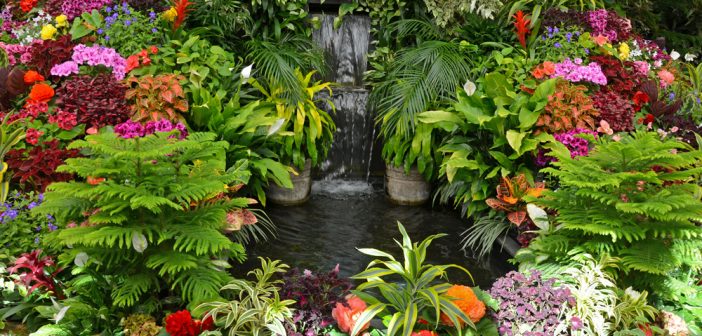A colorful flower bed can add pizzazz to your outdoor space. The right choices can make or break your garden, leaving you playing catch-up throughout the year. Paying attention to the small details will pay immediate dividends. A thoughtful mixture of colors, shapes, and heights will leave others green with envy. What are the steps to designing a colorful flower bed of your own? Here is a how-to guide that will help you make the decisions that are right for you and your space.
Location
The first thing to do when planning your proposed garden space is to determine the type of sun exposure that the area you plan to begin gardening receives. Make some observations and jot down the various time and hours that the area is exposed to sunlight. Some gardeners find it helpful to begin a gardening journal. A place to sketch, write your notes, and visualize your garden. This will be helpful when selecting the types of flowers that will be best suited to grow in that given spot.
From there you’ll want to consider the condition of the soil and the amount of water runoff that is present in that area. Taking notes of your observations and putting them into your gardening journal will be a helpful reference as you plan your flower garden. Many popular flower bed locations include around the home’s foundation, along sidewalks and pathways, and yard boundaries. Other favorable sites could be for transitional purposes between main gardening spaces and hardscapes.
Space
Once an area has been designated you’ll need to start planning the proposed dimensions for your flower beds. The shape of your beds can be arranged in endless combinations, shapes, and sizes depending on your preference. Shapes with hard edges–squares and rectangles are simple and functional, while shapely designs can accentuate the natural curves in your landscape. Either style can be appropriate for traditional and modern style landscapes.
Begin by measuring your proposed space and marking the area so that it’s easy to visualize. A helpful tip is to use a sack of all-purpose flour–pouring a border to outline the flower bed’s territory. The flour will easily rinse away with a quick spray of the hose and temporarily provide you a clear picture of the overall size and shape. Record your overall dimensions before rinsing the flour away.
Now that you have an idea of the dimensions and shape, it’s easy to sketch a plan on paper. Try using colored pencils to help you determine the color scheme and placement. Determine the focal points of your garden bed and build on your ideas from there.
Colors
Color schemes can make or break the overall appeal so be sure to not select more than three colors as less is more. From there you can select from a variety of shrubbery, flowers, and plants that vary in shade from the colors you choose. Complementary colors will always work and look best, though other schemes could include monochromatic to complex hues. Look online or visit your local gardening center for inspiration when determining the color scheme.
Remember to consider the exterior colors of the home and to choose flowers that complement the design. To obtain a bountiful appearance, try planting flowers in clusters based on color and mixing in shrubbery to separate the colors. Use lawn sculptures, lighting, and unique plants as focal points to draw attention.
Varying up the warm and cool colors will give your flower bed some balance. Flowers in the back of your bed that don’t get as much attention can have muted colors to blend in and accentuate the focal pieces of your garden. Bright colors with saturated hues can take the lead and draw the eye.
The Right Fit
Once you’ve determined the location, shape, and colors of your flower bed you’ll want to consider the plants that are best suited. Using the recorded observations, look at plants that fit the area’s specifications regarding light, water, and soil. The most successful gardens take into consideration the native plants of the area. These types of plants are more likely to thrive as they are easy to care for and the pollinators will love them.
Drought-tolerant plants like mums and daisies are great for areas with lot’s of sun exposure and can lend a Mediterranean feel, while shade lovers like begonias and fuschia can add splashes of color to brighten up shady spots. Check out the USDA Hardiness Zone Map to help you select plants that will survive best in your location. It can also be helpful to have a soil assessment test to determine the type of soil (clay, sand, loam) you have.
Variety
The basics are covered now, but for a complete garden it is important to consider the various heights, shapes, and sizes of the plants you select once fully matured. A mixture of tall and low plants is best when adding variety–even if only a few inches apart. The pollinators will appreciate having an assortment of shapes and sizes too. Trying positioning larger plants to the rear in order to prevent the short plans from being overshadowed and underappreciated. Medium-height plants planted around shorter ones can highlight and bring more attention.
The Plan
Now that you’ve discovered how much space you have available, the optimal color scheme, and the varieties of flowers available, it’s time to sketch out the plan. It may seem like an unnecessary step in the process, but rest assured, it’s worth it. Below is an easy to reference checklist ensuring that you are ready for your colorful flower bed design.
- • Begin your gardening journal. Observe sun and temperature of desired location.
- • Check the condition of the soil and water runoff. Is this the optimal location for my flower bed?
- • Determine the shape of your garden. Is it oblong, a rectangle, or another shape?
- • Measure out the flower bed area to know what you’re working with. Putting this information into your gardening journal is extremely beneficial.
- • Figure out the color scheme–remembering to stick to a three color rule with a variety of shades.
- • Research the types of flowers that grow well with the amount of sunlight, shade, and temperature available. Does it work in my climate zone?
- • Find the complementary flowers and plants that will fill out your garden. What pests will the flower bring? What pollinators
- • Figure out what the focal point of your garden will be. Do you want a specific type of flower, a water feature, or statue?
- • With your design in place, sketch out the design of your garden in your notebook. Did I think of everything required to make this happen?
- • Head to your local garden center and speak with the experts about your plan. They love to help in any way possible and can provide guidance if you’re stuck.
One of the greatest things about gardening is that if you don’t like something, it’s super easy to make alterations. Have plants that aren’t growing complementary to each other? Add in a new variety to hide it or remedy the situation. Do you notice pests flowing in and eating all of your flowers? Rip those negative flowers out and tell the pests to find a new home with a flower that doesn’t attract them. A colorful flower bed involves a personal relationship with the Earth. Taking your time to figure out what works for you and the space leaves you ready to tackle any challenge.








